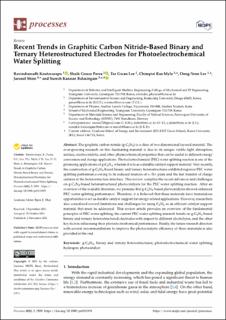| dc.contributor.author | Koutavarapu, Ravindranadh | |
| dc.contributor.author | Peera, Shaik Gouse | |
| dc.contributor.author | Lee, Tae Gwan | |
| dc.contributor.author | Myla, Chimpiri Rao | |
| dc.contributor.author | Lee, Dong-Yeon | |
| dc.contributor.author | Shim, Jaesool | |
| dc.contributor.author | Balasingam, Suresh Kannan | |
| dc.date.accessioned | 2022-03-29T08:48:34Z | |
| dc.date.available | 2022-03-29T08:48:34Z | |
| dc.date.created | 2021-12-02T11:28:36Z | |
| dc.date.issued | 2021 | |
| dc.identifier.citation | Processes. 2021, 9 (11), . | en_US |
| dc.identifier.issn | 2227-9717 | |
| dc.identifier.uri | https://hdl.handle.net/11250/2988205 | |
| dc.description.abstract | The graphitic carbon nitride (g-C3N4) is a class of two-dimensional layered material. The ever-growing research on this fascinating material is due to its unique visible light absorption, surface, electrocatalytic, and other physicochemical properties that can be useful to different energy conversion and storage applications. Photoelectrochemical (PEC) water splitting reaction is one of the promising applications of g-C3N4, wherein it acts as a durable catalyst support material. Very recently, the construction of g-C3N4-based binary and ternary heterostructures exhibited superior PEC water splitting performance owing to its reduced reunion of e-/h+ pairs and the fast transfer of charge carriers at the heterostructure interface. This review compiles the recent advances and challenges on g-C3N4-based heterostructured photocatalysts for the PEC water splitting reaction. After an overview of the available literature, we presume that g-C3N4-based photocatalysts showed enhanced PEC water splitting performance. Therefore, it is believed that these materials have tremendous opportunities to act as durable catalyst support for energy-related applications. However, researchers also considered several limitations and challenges for using C3N4 as an efficient catalyst support material that must be addressed. This review article provides an overview of the fundamental principles of PEC water splitting, the current PEC water splitting research trends on g-C3N4-based binary and ternary heterostructured electrodes with respect to different electrolytes, and the other key factors influencing their photoelectrochemical performance. Finally, the future research direction with several recommendations to improve the photocatalytic efficiency of these materials is also provided at the end. | en_US |
| dc.language.iso | eng | en_US |
| dc.publisher | MDPI | en_US |
| dc.rights | Navngivelse 4.0 Internasjonal | * |
| dc.rights.uri | http://creativecommons.org/licenses/by/4.0/deed.no | * |
| dc.title | Recent trends in graphitic carbon nitride-based binary and ternary heterostructured electrodes for photoelectrochemical water splitting | en_US |
| dc.type | Journal article | en_US |
| dc.type | Peer reviewed | en_US |
| dc.description.version | publishedVersion | en_US |
| dc.source.pagenumber | 26 | en_US |
| dc.source.volume | 9 | en_US |
| dc.source.journal | Processes | en_US |
| dc.source.issue | 11 | en_US |
| dc.identifier.doi | 10.3390/pr9111959 | |
| dc.identifier.cristin | 1963295 | |
| cristin.ispublished | true | |
| cristin.fulltext | original | |
| cristin.qualitycode | 1 | |

